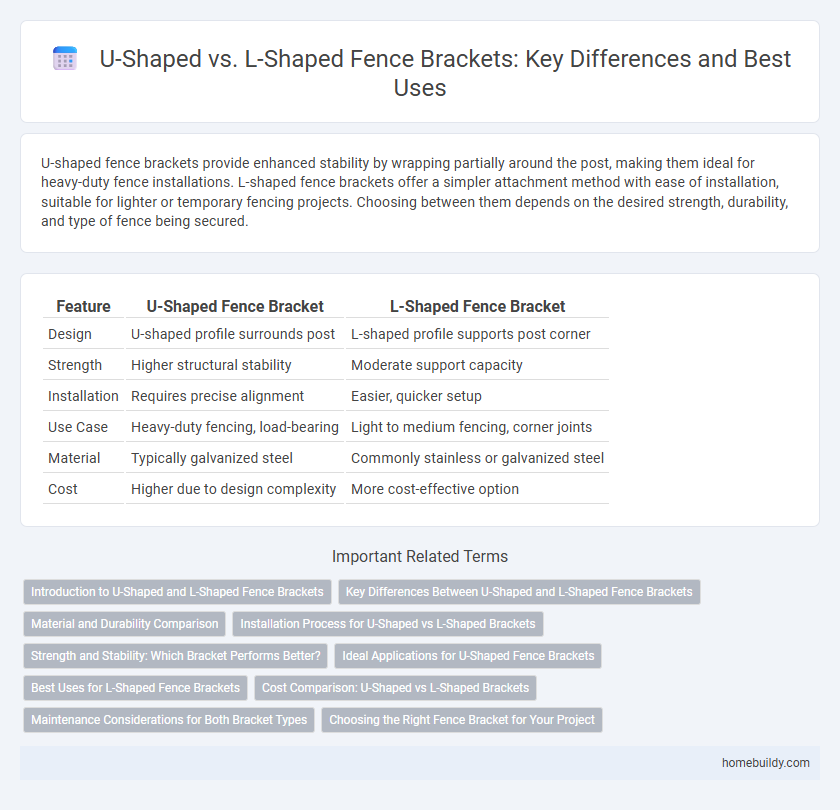U-shaped fence brackets provide enhanced stability by wrapping partially around the post, making them ideal for heavy-duty fence installations. L-shaped fence brackets offer a simpler attachment method with ease of installation, suitable for lighter or temporary fencing projects. Choosing between them depends on the desired strength, durability, and type of fence being secured.
Table of Comparison
| Feature | U-Shaped Fence Bracket | L-Shaped Fence Bracket |
|---|---|---|
| Design | U-shaped profile surrounds post | L-shaped profile supports post corner |
| Strength | Higher structural stability | Moderate support capacity |
| Installation | Requires precise alignment | Easier, quicker setup |
| Use Case | Heavy-duty fencing, load-bearing | Light to medium fencing, corner joints |
| Material | Typically galvanized steel | Commonly stainless or galvanized steel |
| Cost | Higher due to design complexity | More cost-effective option |
Introduction to U-Shaped and L-Shaped Fence Brackets
U-shaped fence brackets provide enhanced stability by wrapping around the fence post, distributing weight evenly for secure attachment. L-shaped fence brackets offer a simple and cost-effective solution, ideal for lightweight fencing or quick installations. Both bracket types are essential components in constructing durable, stable fencing systems with tailored support based on structural needs.
Key Differences Between U-Shaped and L-Shaped Fence Brackets
U-shaped fence brackets provide enhanced stability by wrapping around fence posts, making them ideal for heavy-duty or high-traffic areas, while L-shaped brackets offer a simpler, more cost-effective solution for lighter fence structures. U-shaped brackets distribute forces evenly on three sides, reducing the risk of post rotation, whereas L-shaped brackets attach only on two sides, which may allow more movement under pressure. The choice between U-shaped and L-shaped fence brackets depends on factors such as fence material, load requirements, and installation complexity.
Material and Durability Comparison
U-shaped fence brackets are typically made from heavy-duty steel or galvanized metal, providing enhanced strength and resistance to bending under pressure, making them ideal for supporting heavier fence panels. L-shaped fence brackets often use thinner steel or aluminum, offering moderate durability suitable for lighter fence structures but potentially less resistance to harsh weather conditions. The galvanized coating on U-shaped brackets significantly improves corrosion resistance, extending the lifespan compared to some L-shaped versions that may lack this protective finish.
Installation Process for U-Shaped vs L-Shaped Brackets
U-shaped fence brackets offer a simpler installation process by securely wrapping around fence posts, requiring fewer fasteners and allowing quicker alignment. L-shaped brackets demand precise positioning at right angles, often necessitating additional tools and hardware for stable attachment. Choosing between them depends on ease of setup and the specific structural needs of the fencing project.
Strength and Stability: Which Bracket Performs Better?
U-shaped fence brackets offer superior strength and stability compared to L-shaped brackets due to their full enclosure of the fence post, distributing stress more evenly and reducing movement. L-shaped brackets, while easier to install, provide less support as they only secure two sides of the post, increasing the risk of wobbling under heavy loads or strong winds. For fence installations requiring enhanced durability and resistance to lateral forces, U-shaped brackets are the optimal choice.
Ideal Applications for U-Shaped Fence Brackets
U-shaped fence brackets provide superior stability and support for mounting fence panels on posts with irregular or rounded surfaces, making them ideal for wooden or metal poles. Their design distributes load evenly across the post, reducing stress and enhancing durability in high-wind areas or sloped terrains. Commonly used in agricultural fencing, garden enclosures, and temporary barriers, U-shaped brackets ensure a secure and long-lasting installation compared to L-shaped alternatives.
Best Uses for L-Shaped Fence Brackets
L-shaped fence brackets are optimal for corner posts and gate frames where strong, right-angle support is essential. Their design provides enhanced stability and rigidity, making them ideal for securing fence panels to posts at perpendicular junctions. These brackets are preferred in applications requiring robust reinforcement and precise alignment in fence construction.
Cost Comparison: U-Shaped vs L-Shaped Brackets
U-shaped fence brackets generally cost more than L-shaped brackets due to their increased material use and enhanced structural support. L-shaped brackets offer a budget-friendly option suitable for lighter fence installations, balancing affordability with adequate durability. Choosing between the two depends on project requirements, with U-shaped brackets favored for heavy-duty fencing and L-shaped brackets preferred for cost efficiency.
Maintenance Considerations for Both Bracket Types
U-shaped fence brackets typically require less maintenance due to their enclosed design, which offers enhanced protection against rust and debris accumulation, making them ideal for outdoor environments with high exposure to moisture. L-shaped fence brackets may need more frequent inspection and treatment to prevent corrosion, especially at the exposed edges where water can easily settle. Both bracket types benefit from regular cleaning, rust-proof coatings, and ensuring tight fastener connections to prolong durability and maintain structural integrity.
Choosing the Right Fence Bracket for Your Project
U-shaped fence brackets provide superior stability by wrapping around the post, ideal for heavier or larger fence panels requiring enhanced support. L-shaped fence brackets are more versatile and easier to install, suitable for lighter fences or when budget constraints are a priority. Selecting the right fence bracket depends on project requirements such as load-bearing capacity, fence type, and installation complexity.
U-shaped fence bracket vs L-shaped fence bracket Infographic

 homebuildy.com
homebuildy.com